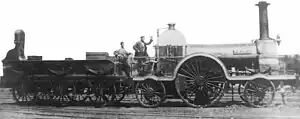| Prince or Queen Class | |||||||||||||||||||
|---|---|---|---|---|---|---|---|---|---|---|---|---|---|---|---|---|---|---|---|
 | |||||||||||||||||||
| |||||||||||||||||||
| |||||||||||||||||||
| |||||||||||||||||||
The Great Western Railway Prince Class 2-2-2 broad gauge steam locomotives for passenger train work. This class was introduced into service between August 1846 and March 1847, and withdrawn between January and September 1870.
From about 1865, the Prince Class locomotives became part of the Priam Class, along with the Fire Fly Class locomotives.
Locomotives
- Moose (1846 - 1870)
- Named after the animal, the elk.
- Peri (1846 - 1870)
- A peri is a fallen angel in Persian mythology.
- Prince (1846 - 1870)
- Named in honour of Albert, Prince Consort to Queen Victoria.
- Queen (1847 - 1870)
- Named in honour of Queen Victoria
- Sylph (1847 - 1870)
- A sylph is an invisible, mythological creature.
- Witch (1846 - 1870)
- This locomotive was fitted with slightly larger 7 ft 6 in (2,286 mm) driving wheels. It was named after a female practitioner of witchcraft, a witch.
References
- Reed, P. J. T. (February 1953). White, D. E. (ed.). The Locomotives of the Great Western Railway, Part 2: Broad Gauge. Kenilworth: RCTS. pp. B18–B19. ISBN 0-901115-32-0.
- Sheppard, Geof (2008). Broad Gauge Locomotives. Southampton: Noodle Books. ISBN 978-1-906419-09-7.
- Waters, Laurence (1999). The Great Western Broad Gauge. Hersham: Ian Allan Publishing. ISBN 0-7110-2634-3 – via Archive.org.
This article is issued from Wikipedia. The text is licensed under Creative Commons - Attribution - Sharealike. Additional terms may apply for the media files.